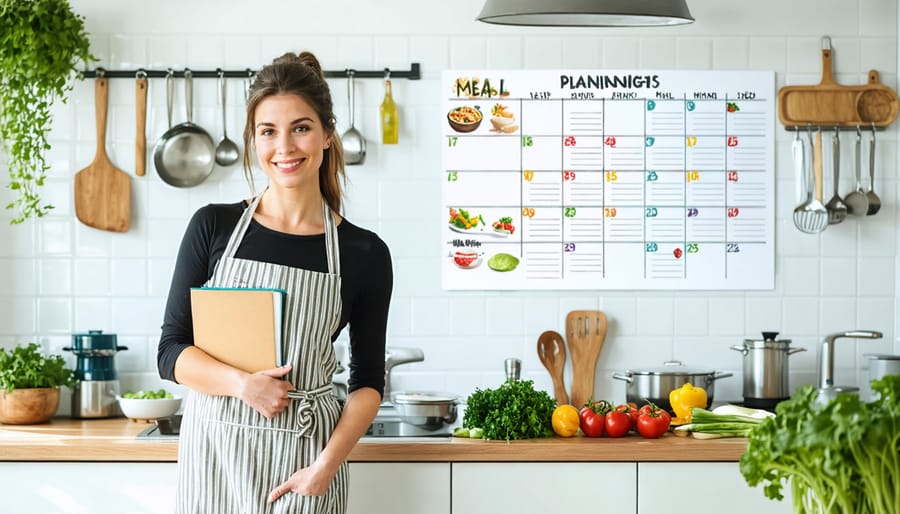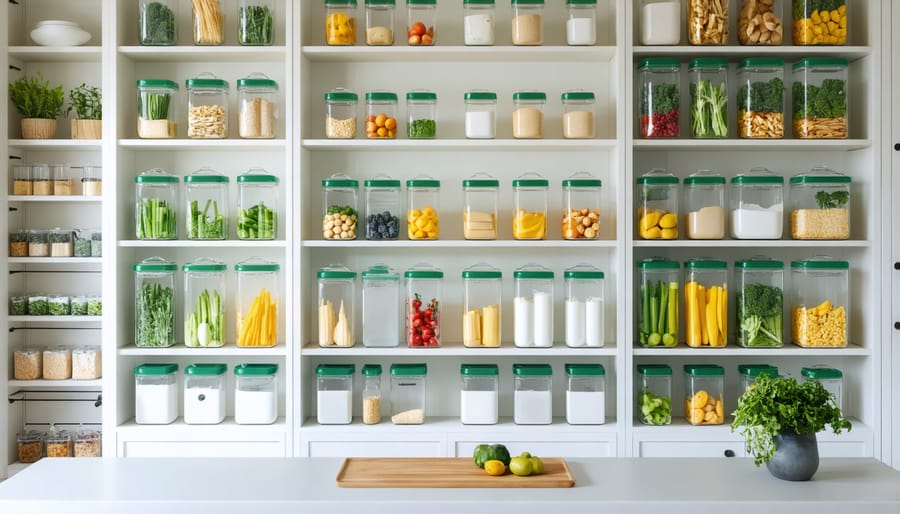
Transform your chaotic weeknight dinner scramble into a streamlined success with a practical meal planning system that actually works for real families. Instead of staring blankly into the fridge at 5 PM or resorting to another takeout night, imagine having a clear roadmap for every meal, complete with a ready-to-go shopping list and simple prep schedule.
As a busy mom of three who’s mastered the art of efficient meal planning, I’ve learned that the secret isn’t perfection – it’s smart preparation that fits your family’s unique rhythm. The right meal planning strategy can save you up to five hours each week, reduce food waste by 40%, and slash your grocery budget while still putting delicious, nutritious meals on the table.
Whether you’re juggling after-school activities, managing picky eaters, or simply trying to maintain your sanity during the dinner rush, a personalized meal planning system can revolutionize your family’s eating habits. The best part? You don’t need to be a master chef or spend hours in the kitchen. With just 30 minutes of strategic planning each week, you can create a sustainable routine that brings calm to your kitchen and joy back to family mealtimes.
Let’s dive into the practical steps that will help you take control of your family’s meal planning journey, starting today.
Why Your Current Meal Planning Isn’t Working
The Weekend Scramble
We’ve all been there – it’s Sunday afternoon, the weekend’s flown by, and suddenly you realize there’s nothing planned for dinner. The dreaded last-minute grocery store rush begins, complete with cranky kids and crowded aisles. I remember one particularly chaotic Sunday when I found myself joining what seemed like half the neighborhood in the produce section, all of us frantically grabbing ingredients for the week ahead.
But here’s the thing: weekend scrambles don’t have to be your norm. Many families fall into this pattern because they haven’t found a system that works for them. While the occasional last-minute shop is inevitable, constant grocery store firefighting adds unnecessary stress to your weekend and usually leads to impulse purchases and forgotten ingredients.
Think of your weekend as precious family time rather than a mad dash through the supermarket. With proper planning, you can transform those frantic Sunday afternoons into relaxed family moments.
The 5PM Panic
We’ve all been there – staring into the fridge at 5 PM, feeling the mounting pressure as hungry family members start asking “What’s for dinner?” It’s that daily moment of panic when you realize you have no plan, limited time, and dwindling energy. Sound familiar? You’re not alone! This dreaded dinnertime scramble affects countless families, leading to stress, unhealthy food choices, and expensive takeout orders.
The 5 PM panic isn’t just about food – it’s about the mental load of daily decision-making when you’re already exhausted. It’s the guilt of serving another thrown-together meal or the frustration of making multiple trips to the grocery store in one week. But here’s the good news: this common struggle has a solution, and it starts with a simple plan. By implementing a structured meal planning system, you can transform this daily source of stress into a manageable, even enjoyable, part of your family routine.
Set Your Kitchen Up for Success
Pantry Power-Up
A well-stocked pantry is like having a secret superpower in your meal planning arsenal. I remember the day I transformed my chaotic cupboard into an organized haven of possibilities – it was a game-changer for our family dinners! The key is focusing on versatile ingredients that can create multiple meals.
Start with your base ingredients: whole grains like quinoa, brown rice, and pasta; protein-rich legumes such as black beans, chickpeas, and lentils; and a variety of canned tomatoes and broths. These foundations, combined with the right helpful kitchen tools, make meal prep a breeze.
Don’t forget your flavor enhancers! Stock up on dried herbs, spices, and condiments that align with your family’s taste preferences. I always keep olive oil, soy sauce, honey, and various vinegars on hand. These ingredients can transform simple pantry meals into exciting dishes your family will love.
Create a “safety net” section in your pantry with quick-fix items like canned tuna, jarred pasta sauce, and boxed mac and cheese for those especially hectic days. The goal isn’t perfection – it’s having reliable options that work for your family’s real life.
Remember to rotate your stock regularly and keep a running inventory list on your phone. This prevents over-buying and ensures you always have your essential ingredients ready to go.

Smart Shopping Lists
Gone are the days of scribbling grocery lists on random scraps of paper! As a busy mom of two, I’ve learned that a well-organized shopping list is the backbone of successful meal planning. Let me share some game-changing strategies that have transformed my grocery shopping routine.
First, create a master list of staple items your family regularly uses. Keep this digital – whether in your phone’s notes app or a dedicated meal planning app. Categories like produce, proteins, pantry items, and household essentials make navigation a breeze during shopping.
Consider organizing your list based on your grocery store’s layout. This simple trick has cut my shopping time in half! Start with non-perishables and end with frozen items. Pro tip: Keep a running list throughout the week as items run low, and encourage family members to add to it immediately when they use the last of something.
Take advantage of technology – many grocery stores now offer apps that let you create lists and show you exactly which aisle contains each item. Some even notify you of sales on your frequently purchased items. For the tech-savvy, smart home devices can make list-making as simple as saying, “Add milk to my shopping list.”
Remember to review your meal plan before finalizing your list, and always double-check your pantry to avoid buying duplicates. A smart shopping list isn’t just about organization – it’s about making your life easier and your grocery trips more efficient.
The 15-Minute Meal Planning Method
Theme Nights
Theme nights can be a game-changer for busy families, bringing structure and fun to your weekly meal planning routine. By designating specific themes for each day, you’ll eliminate the daily “what’s for dinner?” dilemma while creating enjoyable family traditions. Popular themes include Meatless Monday, Taco Tuesday, and Pizza Friday, but feel free to create themes that resonate with your family’s preferences.
These themed nights can help develop mindful cooking habits while making grocery shopping more efficient since you’ll know exactly what ingredients you need each week. Consider themes like International Wednesday, where you explore different cuisines, or Breakfast-for-Dinner Thursday, which kids particularly love.
To get started, choose 3-4 themes that work for your family and gradually add more. Keep a rotating list of recipes within each theme to prevent monotony. For instance, Taco Tuesday could alternate between traditional tacos, fish tacos, or even taco-inspired salads. Remember, themes should simplify your life, not add pressure, so stay flexible and adjust as needed to fit your family’s schedule and preferences.
Double-Duty Ingredients
Smart meal planning isn’t just about cooking different dishes – it’s about making your ingredients work smarter, not harder! One of my favorite time-saving tricks is planning meals that share common ingredients in creative ways. For instance, that rotisserie chicken you picked up can star in Monday’s chicken Caesar salad and transform into Tuesday’s chicken enchiladas.
When I do my weekly shopping, I always look for versatile ingredients that can shape-shift throughout the week. Ground beef can become classic spaghetti bolognese one night and taco filling the next. Roasted vegetables can accompany a protein for dinner, then jazz up tomorrow’s lunch wrap or grain bowl.
Think about ingredients that can play multiple roles: quinoa works as a side dish, forms the base of a buddha bowl, or adds protein to a soup. Bell peppers can be stuffed for dinner, diced raw for salads, or sautéed for fajitas. Even basic items like cheese, herbs, and prepared sauces can elevate multiple dishes throughout the week.
The key is thinking ahead and spotting these double-duty opportunities when planning your menu. It’s like having a secret weapon in your meal-planning arsenal!
Prep Once, Eat Twice
As a busy mom of three, I’ve learned that effective meal prep strategies are absolute game-changers. The secret? Cook once, but make it count double! When preparing Sunday’s roast chicken, I always cook an extra one. That second bird becomes Monday’s chicken fajitas and Tuesday’s hearty soup.
Start by identifying meals that can easily transform into new dishes. Ground beef can become tonight’s pasta sauce and tomorrow’s taco filling. Roasted vegetables can accompany your protein today and become a delicious frittata tomorrow morning. The key is thinking two steps ahead.
Set aside two hours on weekends for batch cooking basics: rice, quinoa, roasted vegetables, and protein options. Store these building blocks in clear containers at eye level in your fridge. This approach saves not just time but also mental energy – no more 5 PM panic about what’s for dinner!
Pro tip: Invest in good quality storage containers and label everything with both contents and dates. Your future self will thank you when reaching for that perfectly portioned, ready-to-go meal component during the weekday rush.
Family-Friendly Meal Planning Tools

Apps That Actually Help
Let’s face it – our phones are always with us, so why not put them to work in the kitchen? After testing countless meal planning apps (and deleting quite a few!), I’ve found some genuine gems that make feeding the family so much easier.
Mealime has been a game-changer for many busy parents in our community. It creates personalized meal plans based on your family’s preferences and dietary restrictions, plus generates smart shopping lists that you can sync with grocery delivery services. One mom told me she saved two hours weekly just by switching to this app!
Plan to Eat is perfect if you love collecting recipes from various sources. It lets you drag and drop recipes into a calendar and automatically creates shopping lists. The interface is super intuitive – even my tech-resistant partner figured it out in minutes.
For the budget-conscious family, Paprika is worth every penny of its one-time purchase. It captures recipes from anywhere online, scales ingredients automatically, and helps track what’s in your pantry. Plus, it syncs across devices, so you can meal plan during your lunch break and have your partner start dinner with the same recipe.
These apps aren’t just tools – they’re like having a personal assistant in your pocket!
Physical Planning Tools
Having the right physical planning tools can make meal planning feel less like a chore and more like a manageable part of your family routine. As a busy mom of three, I’ve found that having a dedicated command center in the kitchen is a game-changer.
A large monthly wall calendar is perfect for mapping out your meals, with space to note activities that might affect dinner times. Many families love using magnetic meal planning boards, which often come with handy pre-made cards for common meals and space for grocery lists.
For the more creative planners, a chalkboard or whiteboard can be both functional and decorative. I’ve seen families transform a kitchen wall into a beautiful menu display using chalkboard paint, adding a fun element that gets the kids involved in meal planning.
Don’t overlook the power of a simple clipboard hanging on the fridge with your weekly meal plan and shopping list. Some families even create a recipe binder with clear sleeves for favorite recipes and a section for new ones to try.
Remember, the best planning tool is the one you’ll actually use consistently. Start with something simple and adjust as you discover what works best for your family’s rhythm.

Getting the Family On Board
Getting your family excited about family-friendly meal planning can be a game-changer for your weekly routine. Start by hosting a casual family meeting during dinner to discuss everyone’s favorite meals and new dishes they’d like to try. My own kids love being “junior chefs,” and I’ve found that giving them age-appropriate tasks makes them more invested in our meals.
Create a rotating schedule where each family member gets to choose one dinner per week. This not only shares the decision-making but also ensures everyone has something to look forward to. Keep a colorful chart on the fridge where family members can add meal suggestions or mark their favorites with stickers.
For younger children, make it fun by letting them help with safe tasks like washing vegetables or setting the table. Teenagers can take on more responsibility, perhaps planning and preparing an entire meal once a week. Remember to celebrate small wins and be patient – building new habits takes time, but the payoff of having an engaged, supportive family makes it all worthwhile.
You’ve got this! Remember, meal planning doesn’t have to be perfect to be effective. Start small by implementing just one or two strategies that resonate with your family’s lifestyle. Maybe begin with planning three dinners a week, or try batch cooking on Sunday afternoons. As you become more comfortable, gradually expand your planning routine.
Keep your meal planning tools in an easily accessible place, whether it’s a dedicated planning app on your phone or a simple notebook on your kitchen counter. Get your family involved by having weekly “menu meetings” where everyone can contribute ideas and preferences. This not only makes the process more manageable but also increases buy-in from even the pickiest eaters.
Don’t be too hard on yourself when things don’t go as planned – flexibility is key in busy family life. Remember that every planned meal is a win, saving you time, money, and mental energy. With consistent practice, meal planning will become second nature, transforming from a challenging task into a helpful habit that serves your family well.
Take that first step today. Your future self will thank you for making mealtime less stressful and more enjoyable for everyone.



